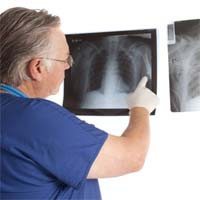Preventing New Tumor “Seeding” After Mesothelioma Biopsy
 Doctors in England are testing a method they hope will reduce the likelihood of pleural mesothelioma patients developing new tumors in their chest wall after a biopsy.
Doctors in England are testing a method they hope will reduce the likelihood of pleural mesothelioma patients developing new tumors in their chest wall after a biopsy.
A tissue sample is required to make a definitive mesothelioma diagnosis.
But as many as 15 percent of mesothelioma patients who undergo some kind of invasive biopsy procedure will develop tiny new tumors along the tracks of the intervention site.
Now, doctors at medical centers across England are performing the first randomized trial of prophylactic irradiation of those intervention sites as a way of preventing new mesothelioma tumors.
Mesothelioma Biopsy Options
There is no blood test for mesothelioma. Instead, patients suspected of having the asbestos cancer will undergo a thorough exam, a health and work history, imaging studies and, usually, a procedure to remove some cells from the suspected mesothelioma tumor site.
There are several methods that can be used to obtain mesothelioma cells for biopsy. If the tumor is small, a CT-guided needle biopsy may be used. Other options include video-assisted thoracoscopic surgery (VATs), thoracoscopy, or open thoracotomy.
Unfortunately, all of these invasive procedures have been linked to the “seeding” of new mesothelioma tumors, especially along the tracks where the needles or other instruments are inserted.
Preventing New Mesothelioma Tumors
The answer to preventing new mesothelioma tumors after a biopsy procedure may be to irradiate those areas before there are any new signs of mesothelioma.
Although this prophylactic irradiation, also known as PIT, is regularly used as a way to treat mesothelioma tumor seeding, there has never been a formal, randomized study of the practice to find out how well it actually works.
PIT in Mesothelioma Treatment
To test the effectiveness of PIT in preventing new mesothelioma tumors after biopsy, doctors at more than half a dozen English hospitals have randomly assigned 374 mesothelioma patients to either receive PIT or not.
For those who will be receiving PIT, it will be given in three fractions of 21 Gy each. Subsequent mesothelioma treatment, such as chemotherapy, is up to the patients’ oncologists.
Researchers are hoping to be able to show a reduction in the number of new mesothelioma tumors springing up after biopsy.
“A reduction in the incidence of chest wall nodules from 15% to 5% in favour of radiotherapy 6 months after randomization would be clinically significant,” writes investigator Dr. Neil Bayman, an oncologist with the Christie Hospital NHS Foundation Trust in Manchester.
The study finished recruiting new patients in December. Participating mesothelioma patients will be followed for 6 months for evidence of new chest wall nodules. Results should be available in late 2016.
Source:
Bayman, N et al, “Protocol for PIT: a phase III trial of propnhylactice irradiation of tracts in patients with malignant pleural mesothelioma following invasive chest wall intervention”, January 27, 2016





